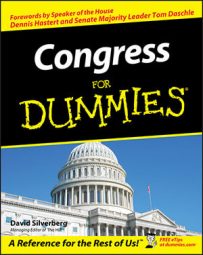After Congress passes a bill, it doesn't become law without the president's signature, and if he vetoes it, it may not be enacted at all (although Congress has the option of overriding the veto). Thus, the president is an immensely powerful presence throughout the legislative process despite his small constitutional role.
The president's role in legislation begins while legislation is being formed. "There's no lobby more powerful than the President of the United States," a powerful lobbyist once said. That lobbyist is right. In our system of government, the president can't command, because the president must go to Congress like anyone else and convince the members to do what he wants. Congress can accept or reject the president's recommendations.
Having said that, remember that the president is unlike any other lobbyist. The major difference, of course, is that the president is the highest elected official of the land, leads the executive branch of the government, oversees the economy, and serves as commander-in-chief of the armed forces, making him responsible for the defense of the nation. A majority of the people gave him a mandate to govern, and, as a result, he speaks for the entire nation at home and abroad. When he speaks, he can talk to the entire country at once, if he so desires.
The president has a team of legislative liaisons, political advisors and policy specialists constantly monitoring congressional activity. They stay in touch with the congressional leadership of both chambers, helping to shape legislation as it moves through Congress.
The White House can't monitor all bills, but it pays close attention to those that it thinks are important, and if it wants changes, it often gets them, especially when the president's party is in power in one or both of the chambers. All that it takes is a word to the leadership or the appropriate legislator.
When the opposing party is in power in one of the chambers, the president has a much tougher job because lobbying has to be much more active, especially when Congress seems bent on passing legislation the president doesn't like.
The president's lobbying efforts are just like yours: It takes salesmanship. The president and his officials have to convince a majority of Congress to go along with his desires. However, three differences exist between you and the president when it comes to lobbying Congress:
- He's the president and you're not.
- He has many more tools at his disposal to convince members of Congress to do what he wants.
- He has a veto.
When the president wants something, he can draw on a wide variety of instruments to convince members to accede to his desires. He can
- Promise them federal benefits like public works projects in their states or districts.
- Aid their pet projects and programs.
- Campaign for them at election time.
- Mobilize the entire country on behalf of his agenda or against his opponents.
- Command more media attention than any other official.
- Raise more money than any other public figure on behalf of his supporters.
- Place friends, constituents, and relatives of supportive members in official positions.
- Propose all sorts of honors and awards for friends and allies.
- Appeal to members' sense of duty and patriotism.
One of the president's most effective tools is the official hospitality of the White House. Having members over for breakfast or lunch or inviting them to a state dinner replete with glamorous celebrities produces an extraordinary effect even with veteran lawmakers accustomed to public attention. The White House actually is a rather modest building, but it exerts a hypnotic effect on its invited guests.
Given the president's power, knowledge and influence, by the time a bill reaches his desk, it's usually shaped to his liking, especially when he's working with a friendly Congress.
However, when Congress is in unfriendly hands, it may pass legislation that the president doesn't like and the president, therefore, may have to use the ultimate constitutional tool: the veto.
Wielding the veto
After Congress sends the president a final bill, he has 10 days to act on it in one of two ways:
- Sign it into law. If he doesn't want to sign it but doesn't want to veto it, he can simply ignore it and it becomes law in ten days (excepting Sundays) while Congress is in session.
- Veto it. The word "veto" literally means "I refuse" in Latin, and the president has the constitutional power to stop a piece of legislation in its tracks, even after it's been through the entire legislative process. It's the Constitution's ultimate executive check on legislation.
- The president can veto a bill in two ways:
• The return veto: The return veto mechanism is a straightforward provision in the Constitution. The president simply refuses to sign the legislation into law and sends it back to Congress with a message explaining why the legislation wasn't signed.
• The pocket veto: In a pocket veto, the president neither vetoes a bill nor signs it — but if Congress adjourns during the 10-day period when the president has the bill, the bill doesn't become law. In other words, the president puts the bill in his pocket, waits out the Congress, and nothing happens.
Overriding a veto
When the president vetoes a bill, the legislation is dead unless Congress takes action.
Congress can override the veto, and in doing so, passes the bill over the president's formal objection. Overriding a presidential veto requires a two-thirds majority vote of the members present and voting (in other words, those who are actually in the chamber rather than two-thirds of the total) in each chamber.
An override vote is a momentous step and difficult to win. In recent years the mere threat of a veto has been enough to convince members not to proceed with provisions that the president doesn't like.

